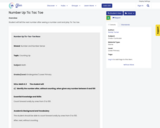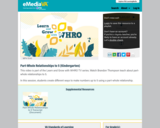
Student will tell the next number after seeing a number card and play Tic Tac toe.
- Subject:
- Cross-Curricular
- Material Type:
- Game
- Author:
- Sandy Turner
- Date Added:
- 05/20/2022

Resources to support the Mathematics Standards of Learning for Lower Primary grades

Student will tell the next number after seeing a number card and play Tic Tac toe.

Use this game to reinforce the concept of odd and even numbers. This game can be played as a teacher led whole group activity. The ppt. slides can be displayed by the teacher on the white board and students can solve the riddles on their dry erase board and then show their answers to the teacher.

This video is part of the Learn and Grow with WHRO TV series. Watch Xenia Clare teach about the concept of even and odd numbers.

Order three sets from least to greatest or greatest to leastMathematics Instructional Plans (MIPs) help teachers align instruction with the Mathematics Standards of Learning (SOL) by providing examples of how the knowledge, skills and processes found in the SOL and curriculum framework can be presented to students in the classroom.

Students will use an unplugged computer science task of sorting networks to order numbers, least to greatest.

This video is part of the Learn and Grow with WHRO TV series. Watch Brandon Thompson teach about comparing objects using comparison vocabulary.

Students will order a set of three numbers from least to greatest and greatest to least. Students will then code their Bee-Bot on the matching numerals from least to greatest or greatest to least.

Identifying the ordinal positionsMathematics Instructional Plans (MIPs) help teachers align instruction with the Mathematics Standards of Learning (SOL) by providing examples of how the knowledge, skills and processes found in the SOL and curriculum framework can be presented to students in the classroom.

Collecting, organizing, and representing data in object graphs, picture graphs, and tables Answering questions related to data Mathematics Instructional Plans (MIPs) help teachers align instruction with the Mathematics Standards of Learning (SOL) by providing examples of how the knowledge, skills and processes found in the SOL and curriculum framework can be presented to students in the classroom.

This is a two day lesson. The first day is a lesson about the history of computers. The students will look at pictures of past computers, computers of today and then discuss what they think the computers of the future will be like.The second day, the students will be looking at components of computers with several fun and exciting stations to help them learn the names of the components (parts and types) of computers such as, desktop computer, laptop computer, tablets, mouse, CPU, printer, etc.

In this lesson, students will travel to different stations while participating in various graphing activities. The students will also be creating a whole class survey in one of the stations, where they will be documenting their results and sharing with the whole class when the lesson is complete.

Let’s graph our favorite holiday and learn about each other! This lesson introduces holidays and then allows children to choose their favorite and graph that information as a whole class.

Let’s play with our hands and minds and discover our favorite STEM station!

This engaging lesson offers students multiple opportunities to collect data and create their own charts and graphs as they rotate through fun and exciting stations that incorporate computer science, math, science, and visual art.

Students will dive into the different components of computing systems, as we collect data from our homes to find out what computing systems are most commonly used in our families. Students will practice identifying inputs and output computer systems.

This sorting activity allows the students to explore several hands-on tasks that will encourage the students to use critical thinking skills to categorize and logically sort items by one or more attributes.

Grab your hard hat and tool belt for this lesson, exploring engineering and computer science with the scientific method.

Children are always taught “not to play with their food” but in this sensory lesson, that’s exactly what we are going to do. We are going to use our five senses to explore some healthy fruits. We are going to learn how to gather, use and analyze our data to answer questions.

Identifying ordinal positions first through tenth, using ordered sets of 10 concrete objects. Mathematics Instructional Plans (MIPs) help teachers align instruction with the Mathematics Standards of Learning (SOL) by providing examples of how the knowledge, skills and processes found in the SOL and curriculum framework can be presented to students in the classroom.

This video is part of the Learn and Grow with WHRO TV series. Watch Brandon Thompson teach about part-whole relationships to 5.